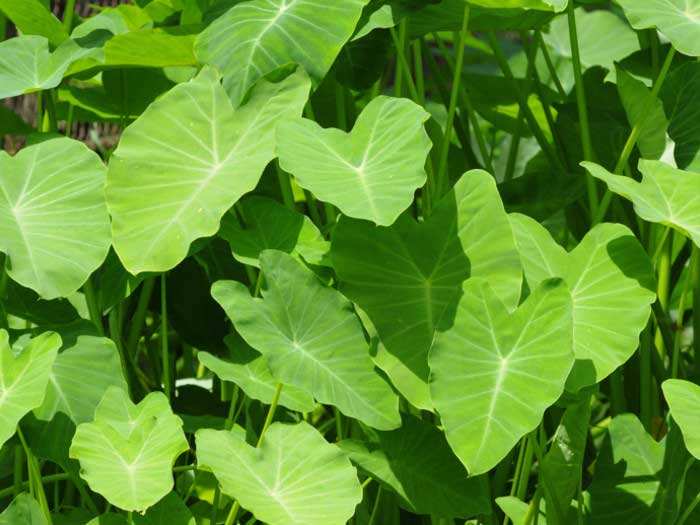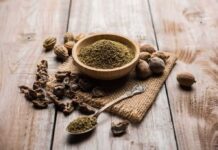
Consuming taro leaves can provide a nutritious boost to your diet, but they also need to be prepared properly to avoid unwanted side effects.
What Are Taro Leaves?
Taro leaves are the edible leaves of the taro plant, which bears the scientific name Colocasia esculenta and is often cultivated for its roots. Taro leaves can also be consumed, provided they are prepared correctly. The surface of the leaves can be highly allergenic and result in skin irritation. Eating the leaves raw can also be toxic, so they must be boiled and properly prepared before adding into any other recipes. [1]
Nutrition Facts
Nutritionally speaking, taro leaves are extremely high in vitamin A, delivering more than 100% of your daily requirement in a single cup. These leaves are also high in vitamin C and various B vitamins, such as thiamine, riboflavin, and folate. There are also significant levels of manganese, copper, potassium, iron, and calcium. A 1-cup serving of these leaves contains only 35 calories, good amounts of dietary fiber, and low levels of fats. [2]
Health Benefits
There are many impressive benefits of taro leaves, particularly because of its dense vitamin and antioxidant levels: [4]
- They may help boost the immune system and protect vision health.
- The fiber in these leaves makes it an excellent option for people who want to relieve their digestive problems, as well as reduce their cholesterol levels.
- These leaves are commonly used for weight loss diets, since they have so few calories, but can fill you up and deliver necessary nutrients.
- Taro leaves can also reduce chronic inflammation and lower blood pressure, thanks to potassium and various anti-inflammatory compounds. [5]
- With high levels of B vitamins, these leaves are associated with the proper development of the fetal brain and strengthening the nervous system.
- High mineral levels mean healthier bones and teeth, and a lower risk of osteoporosis. [6]
- In female reproductive health, these leaves are known to reduce preeclampsia symptoms, and can also help to reduce the appearance of stretch marks.
- The vitamins and antioxidants in these leaves can also improve the appearance of the skin and help with withdrawal symptoms from nicotine.
How to Make Taro Leaves
If you want to make taro leaves or a recipe using them, you will need to make sure you don’t make yourself sick first! While some cultures let their chosen recipe cook the leaves, other cultures prefer to boil the leaves first to ensure all the toxins have been removed.
- Step 1: Bring a pot of water to boil on the stove.
- Step 2: Add your desired amount of leaves to the boiling water.
- Step 3: Allow the leaves to boil for 10-15 minutes.
- Step 4: Drain the leaves thoroughly.
- Step 5: Add them to your recipe as planned!
Side Effects
If not prepared properly, these leaves can be toxic, and if you are using the leaves on the skin, you may experience topical inflammation. Putting the leaves on open wounds can also cause irritation, itchiness, and redness. [7]
Important Notice: This article was originally published at www.organicfacts.net by John Staughton (BASc, BFA) where all credits are due.
Disclaimer
The watching, interacting, and participation of any kind with anything on this page does not constitute or initiate a doctor-patient relationship with Dr. Farrah®. None of the statements here have been evaluated by the Food and Drug Administration (FDA). The products of Dr. Farrah® are not intended to diagnose, treat, cure, or prevent any disease. The information being provided should only be considered for education and entertainment purposes only. If you feel that anything you see or hear may be of value to you on this page or on any other medium of any kind associated with, showing, or quoting anything relating to Dr. Farrah® in any way at any time, you are encouraged to and agree to consult with a licensed healthcare professional in your area to discuss it. If you feel that you’re having a healthcare emergency, seek medical attention immediately. The views expressed here are simply either the views and opinions of Dr. Farrah® or others appearing and are protected under the first amendment.
Dr. Farrah® is a highly experienced Licensed Medical Doctor certified in evidence-based clinical nutrition, not some enthusiast, formulator, or medium promoting the wild and unrestrained use of nutrition products for health issues without clinical experience and scientific evidence of therapeutic benefit. Dr. Farrah® has personally and keenly studied everything she recommends, and more importantly, she’s closely observed the reactions and results in a clinical setting countless times over the course of her career involving the treatment of over 150,000 patients.
Dr. Farrah® promotes evidence-based natural approaches to health, which means integrating her individual scientific and clinical expertise with the best available external clinical evidence from systematic research. By individual clinical expertise, I refer to the proficiency and judgment that individual clinicians acquire through clinical experience and clinical practice.
Dr. Farrah® does not make any representation or warranties with respect to the accuracy, applicability, fitness, or completeness of any multimedia content provided. Dr. Farrah® does not warrant the performance, effectiveness, or applicability of any sites listed, linked, or referenced to, in, or by any multimedia content.
To be clear, the multimedia content is not intended to be a substitute for professional medical advice, diagnosis, or treatment. Always seek the advice of your physician or other qualified health providers with any questions you may have regarding a medical condition. Never disregard professional medical advice or delay in seeking it because of something you have read or seen in any website, video, image, or media of any kind. Dr. Farrah® hereby disclaims any and all liability to any party for any direct, indirect, implied, punitive, special, incidental, or other consequential damages arising directly or indirectly from any use of the content, which is provided as is, and without warranties.








